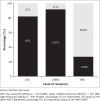Wheelchair service provision education in academia
- PMID: 28936415
- PMCID: PMC5594266
- DOI: 10.4102/ajod.v6i0.340
Wheelchair service provision education in academia
Abstract
Background: An estimated 70 million people with disabilities need wheelchairs. To address this global crisis, the World Health Organization (WHO) proposed an eight-step wheelchair service provision model to ensure service quality regardless of resource setting. The International Society of Wheelchair Professionals (ISWP) aims to facilitate the integration of the WHO eight-step model into professional rehabilitation programmes.
Objective: To develop an enhanced understanding of the current wheelchair service provision education provided in professional rehabilitation programmes worldwide.
Methods: In a cross-sectional design, an online survey was distributed to ISWP contacts of educational institutions. Quantitative responses were analysed through summary statistics and qualitative answers were analysed by content analyses. When relevant, educational institutions were stratified into resource settings.
Results: Seventy-two representatives of educational institutions in 21 countries completed the survey. Wheelchair content was taught in 79% of represented institutions, of which 75% of respondents reported using original course material, 10% of respondents used WHO Wheelchair Service Training Packages and 15% of respondents used other available resources. The majority of educational institutions teaching with their own wheelchair-related course material taught ≤ 20 hours. Fourteen of the 15 respondents without wheelchair education, expressed an interest in integrating wheelchair education into their academic curricula.
Conclusion: The majority of the educational institutions teach wheelchair education; however, there is great variability in what and how it is taught and evaluated. The results demonstrate the need for more in-depth investigation regarding the integration process of wheelchair education in educational institutions, with the ultimate goal of improving wheelchair service provision worldwide.
Conflict of interest statement
The authors declare that they have no financial or personal relationships that may have inappropriately influenced them in writing this article.
Figures
Similar articles
-
Integration of wheelchair service provision education: current situation, facilitators and barriers for academic rehabilitation programs worldwide.Disabil Rehabil Assist Technol. 2020 Jul;15(5):553-562. doi: 10.1080/17483107.2019.1594408. Epub 2019 Apr 23. Disabil Rehabil Assist Technol. 2020. PMID: 31012755
-
Wheelchair service provision education for healthcare professional students, healthcare personnel and educators across low- to high-resourced settings: a scoping review.Disabil Rehabil Assist Technol. 2023 Jan;18(1):67-88. doi: 10.1080/17483107.2022.2037757. Epub 2022 Apr 18. Disabil Rehabil Assist Technol. 2023. PMID: 35436160 Free PMC article.
-
Wheelchair service provision education for healthcare professional students, healthcare personnel and educators across low- to high-resourced settings: a scoping review protocol.Disabil Rehabil Assist Technol. 2023 Apr;18(3):343-349. doi: 10.1080/17483107.2020.1852325. Epub 2020 Dec 10. Disabil Rehabil Assist Technol. 2023. PMID: 33301358
-
Development of a Hybrid Course on Wheelchair Service Provision for clinicians in international contexts.PLoS One. 2018 Jun 15;13(6):e0199251. doi: 10.1371/journal.pone.0199251. eCollection 2018. PLoS One. 2018. PMID: 29906794 Free PMC article.
-
Wheelchair service provision content in professional rehabilitation organisations' standards documents and contemporary initiatives: a rapid review.Disabil Rehabil Assist Technol. 2024 Jan;19(1):78-89. doi: 10.1080/17483107.2022.2063421. Epub 2022 Apr 21. Disabil Rehabil Assist Technol. 2024. PMID: 35446737 Review.
Cited by
-
Development of an Electronic Exchange of Medical Documentation for Power Mobility Devices.Appl Clin Inform. 2021 Mar;12(2):348-354. doi: 10.1055/s-0041-1729166. Epub 2021 Apr 28. Appl Clin Inform. 2021. PMID: 33910261 Free PMC article.
-
Understanding the Global Challenges to Accessing Appropriate Wheelchairs: Position Paper.Int J Environ Res Public Health. 2021 Mar 24;18(7):3338. doi: 10.3390/ijerph18073338. Int J Environ Res Public Health. 2021. PMID: 33804868 Free PMC article.
-
Exploratory investigation of the outcomes of wheelchair provision through two service models in Indonesia.PLoS One. 2021 Jun 1;16(6):e0228428. doi: 10.1371/journal.pone.0228428. eCollection 2021. PLoS One. 2021. PMID: 34061868 Free PMC article.
-
Wheelchair service provision education in Canadian occupational therapy programs.PLoS One. 2022 Feb 17;17(2):e0262165. doi: 10.1371/journal.pone.0262165. eCollection 2022. PLoS One. 2022. PMID: 35176039 Free PMC article.
-
Wheeled and Seated Mobility Devices Provision: Quantitative Findings and SWOT Thematic Analysis of a Global Occupational Therapist Survey.Healthcare (Basel). 2023 Apr 10;11(8):1075. doi: 10.3390/healthcare11081075. Healthcare (Basel). 2023. PMID: 37107909 Free PMC article.
References
-
- Arledge S., Armstrong W., Babinec M., Dicianno B.E., Digiovine C., Dyson-Hudson T. et al. , 2011, RESNA wheelchair service provision guide, RESNA (NJ1), Arlington.
-
- Association of Canadian Occupational Therapy University Programs , 2016, About US, viewed 15 June 2017, from http://www.acotup-acpue.ca/English/about
-
- Best K.L., Kirby R.L., Smith C. & Macleod D.A, 2005, ‘Wheelchair skills training for community-based manual wheelchair users: A randomized controlled trial’, Archives of Physical Medicine and Rehabilitation 86, 2316–2323. - PubMed
-
- Best K.L., Miller W.C. & Routhier F, 2015, ‘A description of manual wheelchair skills training curriculum in entry-to-practice occupational and physical therapy programs in Canada’, Disability and Rehabilitation: Assistive Technology 10, 401–406. - PubMed
-
- Canadian Association of Occupational Therapists , 2012, Profile of occupational therapy practice in Canada, viewed 16 August 2016, from http://www.caot.ca/pdfs/2012otprofile.pdf
LinkOut - more resources
Full Text Sources
Other Literature Sources



